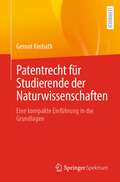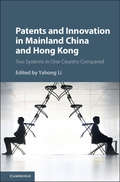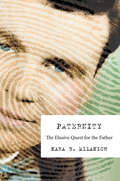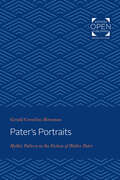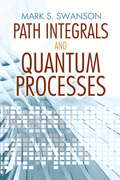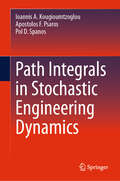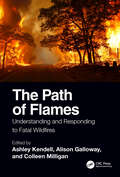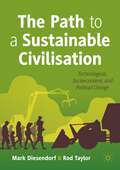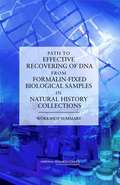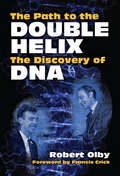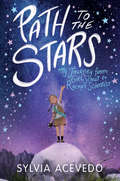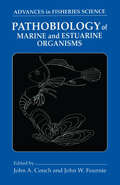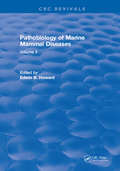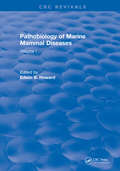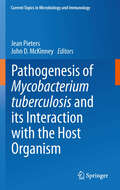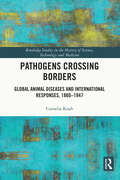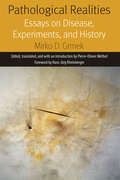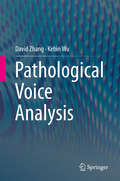- Table View
- List View
Patentrecht für Studierende der Naturwissenschaften: Eine kompakte Einführung in die Grundlagen
by Gernot KrobathDieses Lehrbuch bietet einen kompakten Einstieg in das Patentrecht für Studierende der Naturwissenschaften. Es präsentiert das wesentliche Grundwissen zum deutschen und europäischen Patentrecht. Dabei vertieft sich das Buch bewusst nicht in selten auftretende Spezialfälle oder juristische Feinheiten, sondern es ermöglicht den Lesern, ein Grundverständnis für die zentralen Begriffe und Grundprinzipien des Patentrechts zu entwickeln. Das Lehrbuch enthält zahlreiche Kurzbeispiele und Fallfragen mit Lösungen, anhand derer der Leser die Inhalte verstehen und nachvollziehen kann.
Patents and Innovation in China and Hong Kong: Two Systems in One Country Compared
by Yahong LiHow do patents affect innovation in Mainland China and Hong Kong? How can two patent systems operate within one country and how is innovation affected by the 'one country two systems' model? For the first time, this book links these challenging issues together and provides a comprehensive overview for government officials, law-makers, academics, law practitioners and students to understand the patent systems of Mainland China and Hong Kong. Themes examined include the interaction between the two distinctive patent regimes, the impact of patents on innovation in China's specific industries such as green tech, traditional Chinese medicines and telecommunications, the role of utility models in inflating low-quality patents and the application of good faith principle in enforcing FRAND in Mainland China, patent system reforms in Hong Kong, and the impact of these changes on innovation in the two vastly distinctive yet closely connected jurisdictions.
Paternity: The Elusive Quest for the Father
by Nara B. MilanichFor most of human history, paternity was uncertain. Blood types, fingerprinting, and, recently, DNA analysis promised to solve the riddle of paternity. But even genetic certainty did not end the quest for the father. Rather, as Nara Milanich reveals, it confirms the social, cultural, and political nature of the age-old question: Who’s your father?
Pater's Portraits: Mythic Pattern in the Fiction of Walter Pater
by Gerald Cornelius MonsmanOriginally published in 1967. Monsman undertakes a comprehensive critical analysis of Walter Pater's fiction, which presents the critic with numerous causes of frustration, not the least of which is a lack of both dramatic narration and description. Pater is rarely vivid and firsthand in his fiction; he tends instead toward exposition. Monsman's emphasis in Pater's Portraits is "tracing out" the conscious artistic structure of Pater's fiction. The scope of Pater's writings comprises nothing less than Western culture itself; its subject is all that man has written, thought, said, sung, hoped, or prayed as a civilized creature over two and one-half millennia. Pater's success in handling such panoply is attributable to his discovery of a coherent pattern by which art, religion, and life can be organized. Monsman aims to discover in Pater's fiction the use of old scientific-religious patterns of myth to explain moments of religious and cultural awakening, to reveal the way in which one man arrived at a credo that would answer to the desolation of life and culture.
Path Integrals and Quantum Processes (Dover Books on Physics)
by Mark S. SwansonThis graduate-level text offers a systematic presentation of the path integral approach to calculating transition elements, partition functions, and source functionals. Topics include Grassmann variables, field and gauge field theory, perturbation theory, and nonperturbative results. Requires only some familiarity with quantum mechanics. Numerous exercises. Ideal as course supplement or for independent study. 1992 edition.
Path Integrals in Stochastic Engineering Dynamics
by Ioannis A. Kougioumtzoglou Pol D. Spanos Apostolos F. PsarosThis book organizes and explains, in a systematic and pedagogically effective manner, recent advances in path integral solution techniques with applications in stochastic engineering dynamics. It fills a gap in the literature by introducing to the engineering mechanics community, for the first time in the form of a book, the Wiener path integral as a potent uncertainty quantification tool. Since the path integral flourished within the realm of quantum mechanics and theoretical physics applications, most books on the topic have focused on the complex-valued Feynman integral with only few exceptions, which present path integrals from a stochastic processes perspective. Remarkably, there are only few papers, and no books, dedicated to path integral as a solution technique in stochastic engineering dynamics. Summarizing recently developed techniques, this volume is ideal for engineering analysts interested in further establishing path integrals as an alternative potent conceptual and computational vehicle in stochastic engineering dynamics.
The Path of Flames: Understanding and Responding to Fatal Wildfires
by Ashley Kendell Alison Galloway Colleen MilliganThe Path of Flames: Understanding and Responding to Fatal Wildfires is an edited volume covering the complexities of response and recovery issues relative to catastrophic wildfires. As wildfires become more frequent throughout the world—and the loss of life greater, especially among residents trapped in the path of the flames—it is essential that agencies in fire-prone areas understand the complexity of the response as it relates to finding and identifying the remains of those who perished. While covering wildfire dynamics, risks for vulnerable populations, and the emergency response to wildfires, this book focuses largely on the recovery of human remains within the context of the overall response to mass disasters resulting from wildfires. As such, search protocols, staffing needs, pre-event coordination and organization, and logistical support are addressed. The scientific basis for understanding how fire will affect human remains—as well as how the level of destruction can be interpreted—is also addressed. Recognizing the multidisciplinary nature of the field, this volume covers forensic issues relating to the recovery of remains, forensic anthropology, DNA analysis, forensic odontology, and forensic pathology. The book also includes contributions from international wildfire response professionals looking at global best practices in wildfire response and human remains recovery. Specifically, several chapters cover the lessons learned from the devasting Camp Fire of 2018 in California that led to the deaths of 85 people. The Camp Fire burned nearly 19,000 structures and was ultimately the most destructive—and deadly—in California’s history. The Path of Flames is a one-of-a-kind reference that serves as a valuable resource for professionals working in the areas of emergency services, search and rescue, law enforcement, fire service, disaster planning and response, victim recovery and identification, and mass disaster and mass fatality response.
The Path to a Sustainable Civilisation: Technological, Socioeconomic and Political Change
by Mark Diesendorf Rod TaylorThe Path to a Sustainable Civilisation shows that we have unwittingly fallen into an existential crisis of our own making. We have allowed large corporations, the military and other vested interests to capture governments and influence public opinion excessively. We have created a god called ‘the market’ and allowed our most important decisions to be made by this imaginary entity, which is in fact a human system controlled by vested interests. The result has been the exploitation of our life support system, our planet, and most of its inhabitants, to the point of collapse. This book argues that the way out of our black hole is to build social movements to apply overwhelming pressure on government and big business, weaken the power of vested interests and strengthen democratic decision-making. This must be done simultaneously with action on the specific issues of climate, energy, natural resources and social justice, in order to transition to a truly sustainable civilisation.
Path To Effective Recovering Of Dna From Formalin-fixed Biological Samples In Natural History Collections: Workshop Summary
by National Research Council of the National AcademiesThe National Academies Press (NAP)--publisher for the National Academies--publishes more than 200 books a year offering the most authoritative views, definitive information, and groundbreaking recommendations on a wide range of topics in science, engineering, and health. Our books are unique in that they are authored by the nation's leading experts in every scientific field.
The Path to the Double Helix: The Discovery of DNA (Dover Books on Biology)
by Robert OlbyWritten by a noted biology historian, this classic volume provides the first in-depth account of the 1953 discovery of the molecular structure of DNA by James Watson and Francis Crick. Crick himself, who also provided the Foreword, proclaimed that "no future historian of science in this area will be able to ignore this present volume."
Path to the Stars: My Journey from Girl Scout to Rocket Scientist
by Sylvia AcevedoThe inspiring memoir for young readers about a Latina rocket scientist whose early life was transformed by joining the Girl Scouts and who currently serves as CEO of the Girl Scouts of the USA.A meningitis outbreak in their underprivileged neighborhood left Sylvia Acevedo’s family forever altered. As she struggled in the aftermath of loss, young Sylvia’s life transformed when she joined the Brownies. The Girl Scouts taught her how to take control of her world and nourished her love of numbers and science. With new confidence, Sylvia navigated shifting cultural expectations at school and at home, forging her own trail to become one of the first Latinx to graduate with a master's in engineering from Stanford University and going on to become a rocket scientist at NASA’s Jet Propulsion Laboratory. Simultaneously available in Spanish!
Patho-Epigenetics of Infectious Disease
by Janos Minarovits Hans Helmut NillerEpigenetic modification of cellular genomes is a fascinating means of regulating tissue- and cell type-specific gene expression in all developmental stages of the life of an organism. Carefully orchestrated processes, such as DNA methylation and a plenitude of specific histone modifications secure the faithful transmission of gene expression patterns to progeny cells. Upon chronic infection, the epigenetic cellular balance can become disrupted and, in the long run, through the epigenetic reprogramming of host cell genomes, contribute to the malignant conversion of formerly healthy cells, in many cases preceded by the establishment of an epigenetic field of cancerization. The present volume undertakes to highlight the interactions of infectious pathogens and their effector molecules with the epigenetic regulatory machinery of the cell. Clearly, the recent take-off of epigenetics research did not leave Research on Infectious Diseases and Infection-Associated Cancer untouched. This resulted in a great many of clinically relevant data on understanding the molecular mechanisms of chronic infectious disease. Infectious pathogen- and disease-specific epigenetic alterations are already being used for the early detection of malignant disease and for the prediction of chemotherapy resistance or response to treatment.
Pathobiology of Marine and Estuarine Organisms (Advances In Fisheries Science Ser.)
by John A. Couch; John W. FourniePathobiology of Marine and Estuarine Organisms is a comprehensive, up-to-date review of aquatic animal pathobiology covering infectious and non-infectious diseases of vertebrates such as marine mammals and fishes, in addition to diseases of invertebrates such as crustacea, mollusks, and lower phyla. The book provides critical information on viral, fungal, bacterial, parasitic, and neoplastic diseases of fish and invertebrates. Written by top-notch experts in the field, Pathobiology of Marine and Estuarine Organisms emphasizes pollution-associated diseases and includes an important review on the effects of pollution on marine mammals. The book will be a welcome addition to the libraries of aquatic and marine biologists, aquatic toxicologists, fisheries biologists, aquaculturalists, fish and invertebrate pathologists, and aquatic animal parasitologists.
Pathobiology Of Marine Mammal Diseases: Volume I
by HowardThese volumes provide information which will be helpful to comparative pathologists, veterinarians, and all marine scientists and other individuals who are interested in the study of marine mammals, and the diseases they develop in both their feral and captive environment.This publication is a reflection of the observations of the various authors, some of whom have pioneered in this field, and is an attempt to update the available information concerning the natural diseases, and the corresponding pathologic changes in marine mammals.
Pathobiology Of Marine Mammal Diseases: Volume II
by Edwin B. HowardThese volumes provide information which will be helpful to comparative pathologists, veterinarians, and all marine scientists and other individuals who are interested in the study of marine mammals, and the diseases they develop in both their feral and captive environment.This publication is a reflection of the observations of the various authors, some of whom have pioneered in this field, and is an attempt to update the available information concerning the natural diseases, and the corresponding pathologic changes in marine mammals.
Pathogen removal in aerobic granular sludge treatment systems (IHE Delft PhD Thesis Series)
by Mary Luz Barrios HernàndezThis book describes pathogen removal processes in aerobic granular sludge (AGS) wastewater treatment systems. Faecal indicators (E. coli, Enterococci, coliforms and bacteriophages) were tracked in full-scale AGS facilities and compared to parallel activated sludge (CAS) systems. AGS showed similar removals as the more complex CAS configurations. Removal mechanisms investigated in laboratory-scale reactors showed that the AGS morphology contributes to the removal processes. By tracking E. coli and MS2, it was observed that organisms not attached to the granules are predated by protozoa during aeration. 18S RNA gene analyses confirmed the occurrence of bacterivorous organisms (e.g., Epistylis, Vorticella, Rhogostoma) in the system. Particulate material in the feeding stimulated their development, and a protozoa bloom arose when co-treating with (synthetic) faecal sludge (4 % v/v). An overview of the diverse eukaryotic community in laboratory reactors and real-life applications is also provided. The microbial diversity of the influent was different compared to AGS and CAS sludge samples. However, no clear differences were found between them on species level. This study contributes to a better understanding of the mechanisms behind pathogen removals in AGS systems.
Pathogenesis of Mycobacterium tuberculosis and its Interaction with the Host Organism
by Jean Pieters John D. MckinneyMycobacterium tuberculosis is one of the most notorious pathogens on earth, causing the death of approximately 1. 5 million people annually. A major problem in the fight against tuberculosis is the emergence of strains that have acquired resistance to all available antibiotics. One key to the success of M. tuberculosis as a pathogen is its ability to circumvent host immune responses at different levels. This is not only a result of the special makeup of M. tuberculosis in terms of genetic diversity and DNA metabolism and its possession of specialized secretion systems, but also of its ability to hijack the host's innate immune defence mechanisms. In this volume, researchers from different disciplines provide a topical overview of the diverse mechanisms that contribute to the virulence of M. tuberculosis, ranging from their genetic, metabolic and molecular makeup, as well as the complex strategies these bacteria utilize to escape immune destruction within infected hosts.
Pathogenesis of Systemic Lupus Erythematosus: Insights from Translational Research
by Alberta HoiThe scope of this contributed volume is to provide an overview of the latest translational research in the field of lupus pathogenesis, with particular emphasis on how these discoveries progress in parallel with therapeutic drug development. Systemic lupus erythematosus (SLE) is a multifaceted disease with a number of well-defined immune pathways that are dysregulated, resulting in an immune-mediated chronic inflammatory injury at target organs. As knowledge of these pathways evolves to provide opportunities for targeted drug therapy and lays the foundation for personalized medicine, clinicians and researchers need to keep up with the ever-expanding medical literature.This book will critically appraise the current understanding of important immunological pathways that contribute to the pathogenesis of lupus. We will review the role of interferons as part of the innate immune defects that perpetuate the loss of self-tolerance in SLE. B cell hyperactivity, as a defining hallmark of SLE, and different strategies of B cell targeted therapy will be discussed. The role of co-stimulation or immune checkpoint molecules in activating B and T cells will be reviewed, as well as other cytokines that serve in the amplification loop promoting a more proinflammatory Th1 or Th17 responses. Intracellular targets, such as signaling molecules in the JAK/STAT pathway, or a variety of kinases and proteasomes, can cause a cascading downstream effect of transcriptional responses that are important in SLE. Immune homeostasis can also be restored by bolstering the naturally occurring anti-inflammatory mechanisms. Glucocorticoid, as a potent natural anti-inflammatory hormone, can mediate its effects by recruiting histone deacetylase that serve to repress gene transcription. Glucocorticoid-induced leucine zipper is a gene upregulated by glucocorticoid that can be a potential target for development of anti-inflammatory strategy. Finally, T regulatory cells can be utilized to help restore to immune tolerance and are amongst the latest focus of therapeutic development in SLE.
Pathogenic Yeasts
by Ruth Ashbee Elaine M. BignellMycological studies of yeasts are entering a new phase, with the sequencing of multiple fungal genomes informing our understanding of their ability to cause disease and interact with the host. At the same time, the ongoing use of traditional methods in many clinical mycology laboratories continues to provide information for the diagnosis and treatment of patients. This volume reviews various aspects of pathogenic yeasts and what is known about their molecular and cellular biology and virulence, in addition to looking at clinical and laboratory findings. As each chapter is written by a leading expert in the field, this book summarizes in one volume much of the latest research on several pathogenic yeasts, including Candida, Cryptococcus, Malassezia and yeasts of emerging importance. The importance of laboratory diagnosis, antifungal susceptibility testing, antifungal resistance and yeast diseases in animals are reviewed.
Pathogenic Yersinia: Methods and Protocols (Methods in Molecular Biology #2010)
by Viveka Vadyvaloo Matthew B. LawrenzThis volume delivers a compendium of detailed protocols to the research community in order to aid in the investigation and discovery of Yersinia virulence mechanisms using important in vivo and in vitro infection models, which have led to major advances in the field and in our understanding of Yersinia pathogen-host interactions. Beginning with a section on mouse models, the book continues with chapters covering the monitoring of bacteria during infection, invertebrate models, as well as Yersinia interaction with immune cells and immune signaling. Written for the highly successful Methods in Molecular Biology series, chapters include introductions to their respective topics, lists of the necessary materials and reagents, step-by-step, readily reproducible protocols, and tips on troubleshooting and avoiding known pitfalls. Comprehensive and authoritative, Pathogenic Yersinia: Methods and Protocols provides a single source for researchers seeking to better understand these pathogens and the diseases they produce in humans.
Pathogenicity and Drug Resistance of Human Pathogens: Mechanisms and Novel Approaches
by Saif Hameed Zeeshan FatimaThe book comprehensively discusses the mechanisms of pathogenesis and drug resistance; current diagnostics landscape of four key human pathogens; bacterial, fungal, protozoans and viral which are the causes of major infectious diseases. It also assesses the emerging technologies for the detection and quantification of these pathogens. Further, it discusses the novel opportunities to fight against these infectious diseases and to identify pertinent drug targets with novel methodologies. It also reviews the current and future insights into the control, elimination, and eradication of these infectious diseases. Importantly, the book discusses the epidemiological characteristics and various challenges in combating Ebola and Influenza diseases. Finally, the book highlights the growing role of nanotechnology and bioinformatics resources for combating the infectious diseases. In summary, the book provides the mechanistic insight of the pathogenicity, drug-resistance, therapeutic strategies and identification of the novel drug targets of Mycobacterium tuberculosis, Plasmodium, Candida, Hepatitis C and emerging viral infections.
Pathogens Crossing Borders: Global Animal Diseases and International Responses, 1860–1947 (Routledge Studies in the History of Science, Technology and Medicine #45)
by Cornelia KnabThe increasing globalization of trade, travel and transport since the mid-19th century had unwelcome consequences – one of them was the spread of contagious animal diseases over greater distances in a shorter time than ever before. Borders and national control strategies proved to be insufficient to stop the pathogens. Not surprisingly, the issue of epizootics (epidemics of animals) was among the first topics to be addressed by international meetings from the 1860s onwards. Pathogens Crossing Borders explores the history of international efforts to contain and prevent the spread of animal diseases from the early 1860s to the years after the Second World War. As an innovative contribution to global history and the history of internationalism, the book investigates how disease experts, politicians and state authorities developed concepts, practices and institutional structures at the international level to tackle the spread of animal diseases across borders. By following their activities in dealing with a problem area which was – and is today – of enormous political, social, public health and economic relevance, the book reveals the historical challenges of finding common international responses to complex and pressing global issues for which there are no easy solutions.
Pathogens for War
by Donald H. AveryPathogens for War explores how Canada and its allies have attempted to deal with the threat of germ warfare, one of the most fearful weapons of mass destruction, since the Second World War. In addressing this subject, distinguished historian Donald Avery investigates the relationship between bioweapons, poison gas, and nuclear devices, as well as the connection between bioattacks and natural disease pandemics. Avery emphasizes the crucially important activities of Canadian biodefence scientists - beginning with Nobel Laureate Frederick Banting - at both the national level and through cooperative projects within the framework of an elaborate alliance system.Delving into history through a rich collection of declassified documents, Pathogens for War also devotes several chapters to the contemporary challenges of bioterrorism and disease pandemics from both national and international perspectives. As such, readers will not only learn about Canada's secret involvement with biological warfare, but will also gain new insights into current debates about the peril of bioweapons - one of today's greatest threats to world peace.
Pathological Realities: Essays on Disease, Experiments, and History (Forms of Living)
by Mirko Grmek Pierre-Olivier Méthot Hans-Jörg RheinbergerMirko D. Grmek (1924-2000) is one of the most significant figures in the history of medicine, and has long been considered a pioneer of the field. The singular trajectory that took Grmek from Yugoslavia to the academic culture of post-war France placed him at the crossroads of different intellectual trends and made him an influential figure during the second half of the twentieth century. Yet, scholars have rarely attempted to articulate his distinctive vision of the history of science and medicine with all its tensions, contradictions, and ambiguities. This volume brings together and publishes for the first time in English a range of Grmek’s writings, providing a portrait of his entire career as a historian of science and an engaged intellectual figure. Pathological Realities pieces together Grmek’s scholarship that reveals the interconnections of diseases, societies, and medical theories.Straddling the sciences and the humanities, Grmek crafted significant new concepts and methods to engage with contemporary social problems such as wars, genocides and pandemics. Uniting some major strands of his published work that are still dispersed or simply unknown, this volume covers the deep epistemological changes in historical conceptions of disease as well as major advances within the life sciences and their historiography. Opening with a classic essay – “Preliminaries for a Historical Study of Diseases,” this volume introduces Grmek’s notions of “pathocenosis” and “emerging infections,” illustrating them with historical and contemporary cases. Pathological Realities also showcases Grmek’s pioneering approach to the history of science and medicine using laboratory notebooks as well as his original work on biological thought and the role of ideologies and myths in the history of science. The essays assembled here reveal Grmek’s significant influence and continued relevance for current research in the history of medicine and biology, medical humanities, science studies, and the philosophy of science.
Pathological Voice Analysis
by David Zhang Kebin WuWhile voice is widely used in speech recognition and speaker identification, its application in biomedical fields is much less common. This book systematically introduces the authors’ research on voice analysis for biomedical applications, particularly pathological voice analysis. Firstly, it reviews the field to highlight the biomedical value of voice. It then offers a comprehensive overview of the workflow and aspects of pathological voice analysis, including voice acquisition systems, voice pitch estimation methods, glottal closure instant detection, feature extraction and learning, and the multi-audio fusion approaches. Lastly, it discusses the experimental results that have shown the superiority of these techniques. This book is useful to researchers, professionals and postgraduate students working in fields such as speech signal processing, pattern recognition, and biomedical engineering. It is also a valuable resource for those involved in interdisciplinary research.
